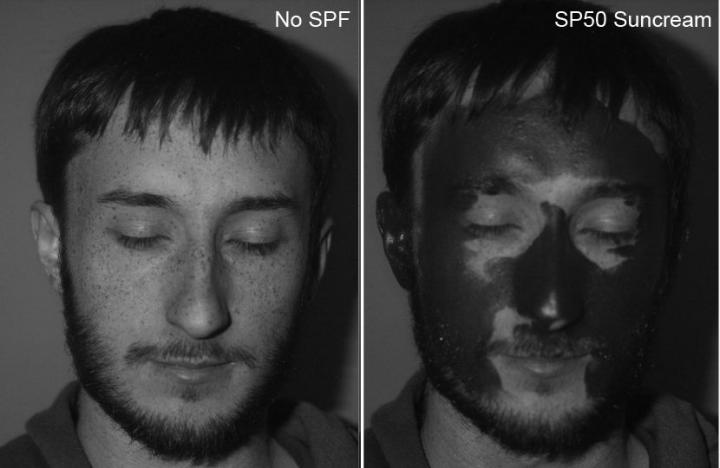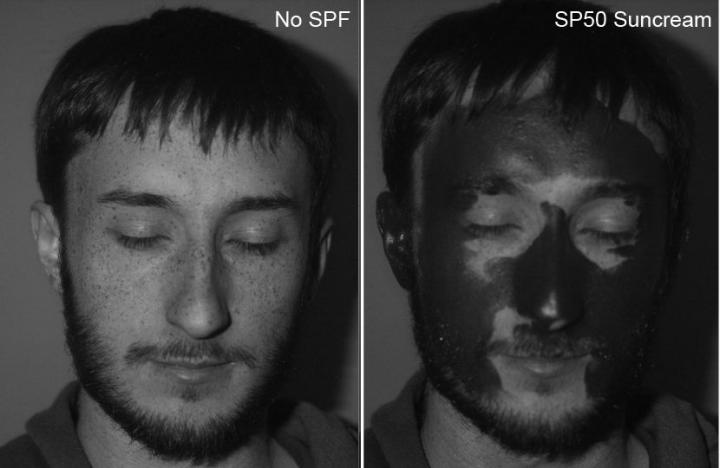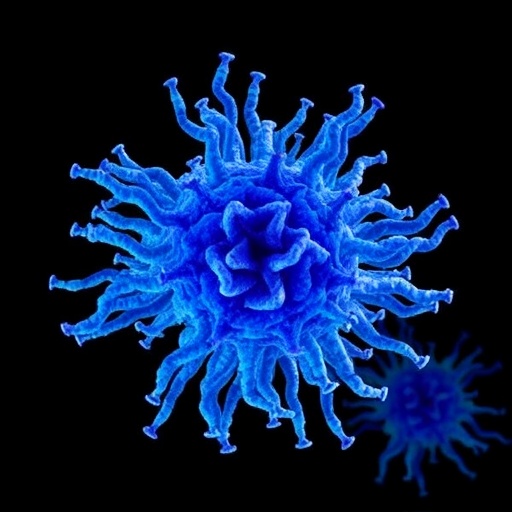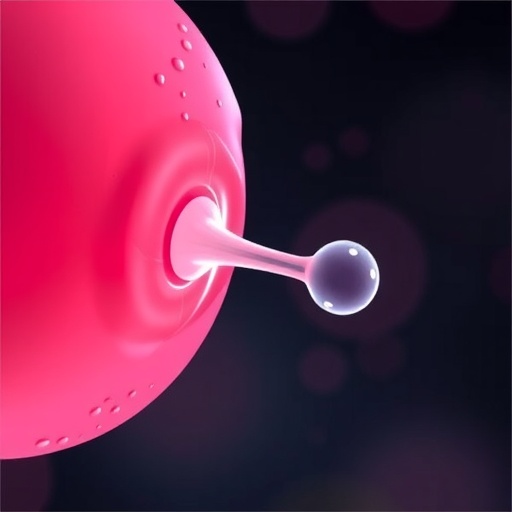
Credit: University of Liverpool
Snow fanatics are no doubt aware of the risk of getting sunburnt on the slopes, but a new study shows that it is more than a red face that skiers and snowboarders should be concerned about.
The study, published by scientists from the Department of Eye & Vision Science at the University of Liverpool, shows that people may not be taking as good care of their face and eyes as they should, with potentially devastating results.
They asked participants to apply sunscreen to their faces. Before and after photos were taken with a UV-sensitive camera, with areas covered with sunscreen appearing black (see attached before and after photographs). Analysis showed that on average people missed 9.5% of their faces, with the most commonly missed areas being the eyelids and the area between the inner corner of the eye and the bridge of the nose. Even when given extra information about skin cancers of the eyelid region, 7.7% of participants' faces were left unprotected.
The dangers of UV exposure
As more than 90% of basal cell carcinomas occur on the head or neck, and 5-10% of all skin cancers occur on the eyelids, this is worrying news, and should be of particular concern to people taking to the slopes this winter.
Many people will already be aware of the combined threat to their skin of higher altitude (less atmospheric protection from UV radiation) and snow glare (reflecting sun back onto the skin), but this study shows that many people may not be taking as good care of their eyes and skin as they should.
Dr Kevin Hamill from the University of Liverpool explained:
"The eyes, and the skin around them, are especially vulnerable to UV radiation and cancers, so skiers and snowboarders who are at risk of high exposure really need to take care. A thoroughly-applied sunblock of at least SPF 30 is a good start but isn't enough. You need to make sure that you take your cream to the slopes and reapply at regular intervals. You also need to wear goggles or sunglasses. Wrap around frames that protect the whole eye area and have 100% UV protection are ideal."
###
Notes for editors
1. The full study can be read here https://doi.org/10.1371/journal.pone.0185297
2. The study asked 57 participants, male and female, to apply sunscreen to their face with no further information or instructions given by the researchers. Photos were taken of each of the participants with a UV-sensitive camera before and after the application of sunscreen, with areas covered with sunscreen appearing black due to the UV camera. These images were then segmented and analysed by a custom-designed program to judge how successful each person was at covering their whole face.
On average people missed 9.5 per cent of the whole face, with the most commonly missed areas being the eyelids (13.5 per cent) and the area between the inner corner of the eye and the bridge of the nose (77 per cent).
The researchers then asked the participants back to repeat the experiment, this time giving extra information about skin cancers of the eyelid region. Armed with this information there was a slight improvement in the level of sunscreen coverage with 7.7% per cent of the face left unprotected.
3. Dr Hamill and colleagues are available for interview on request. Please contact Karen Miller on 0151 706 4098 or Simon Wood on 0151 794 8356.
4. The Department of Eye & Vision Science is part of the Institute of Ageing & Chronic Disease at the University of Liverpool. The department is working to transform understanding of the eye and the process of 'seeing'. Scientists, engineers and clinicians work from cornea to cortex and from bench to bedside, to uncover how basic mechanisms, processes and structures relate to vision. This work is having life-changing results for patients of all ages right across the globe.
5. The University of Liverpool is one of the UK's leading research institutions with an annual turnover of £480 million, including £102 million for research. Liverpool is ranked in the top 1% of higher education institutions worldwide and is a member of the Russell Group. Visit http://www.liv.ac.uk or follow us on twitter at: http://www.twitter.com/livuninews
Media Contact
Simon Wood
[email protected]
44-151-794-8356
@livuninews
http://www.liv.ac.uk
Related Journal Article
http://dx.doi.org/10.1371/journal.pone.0185297





